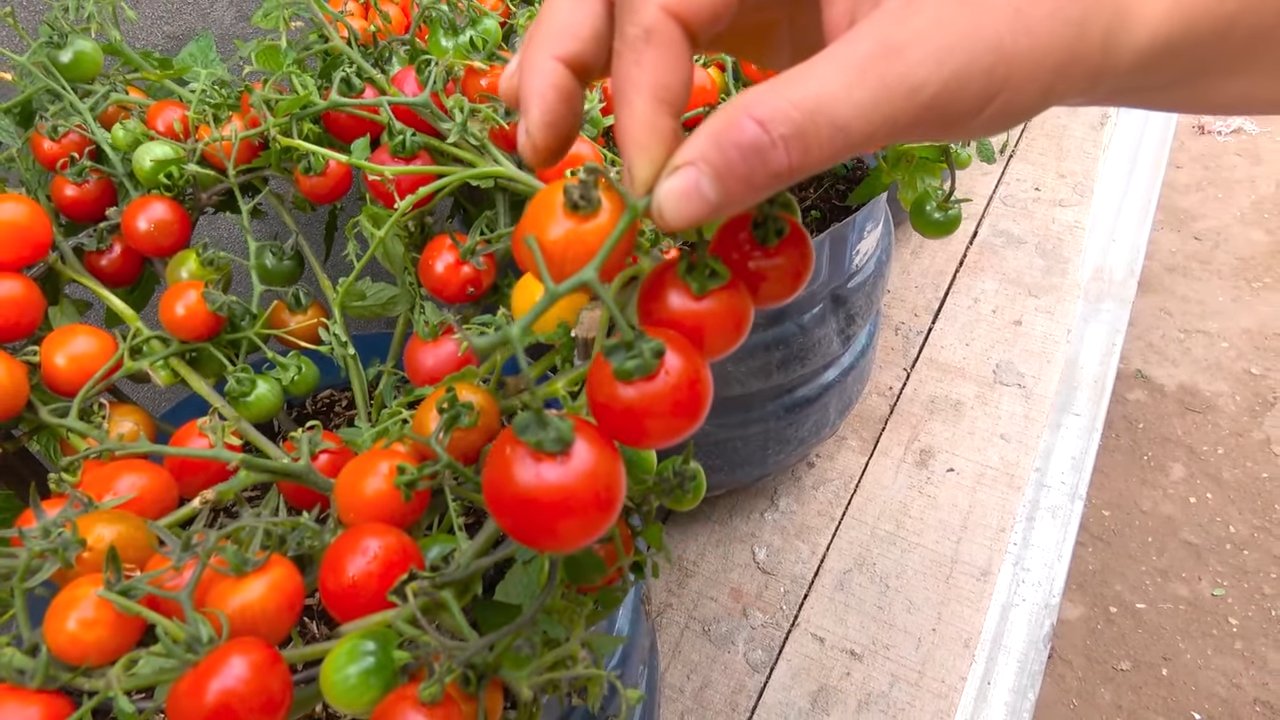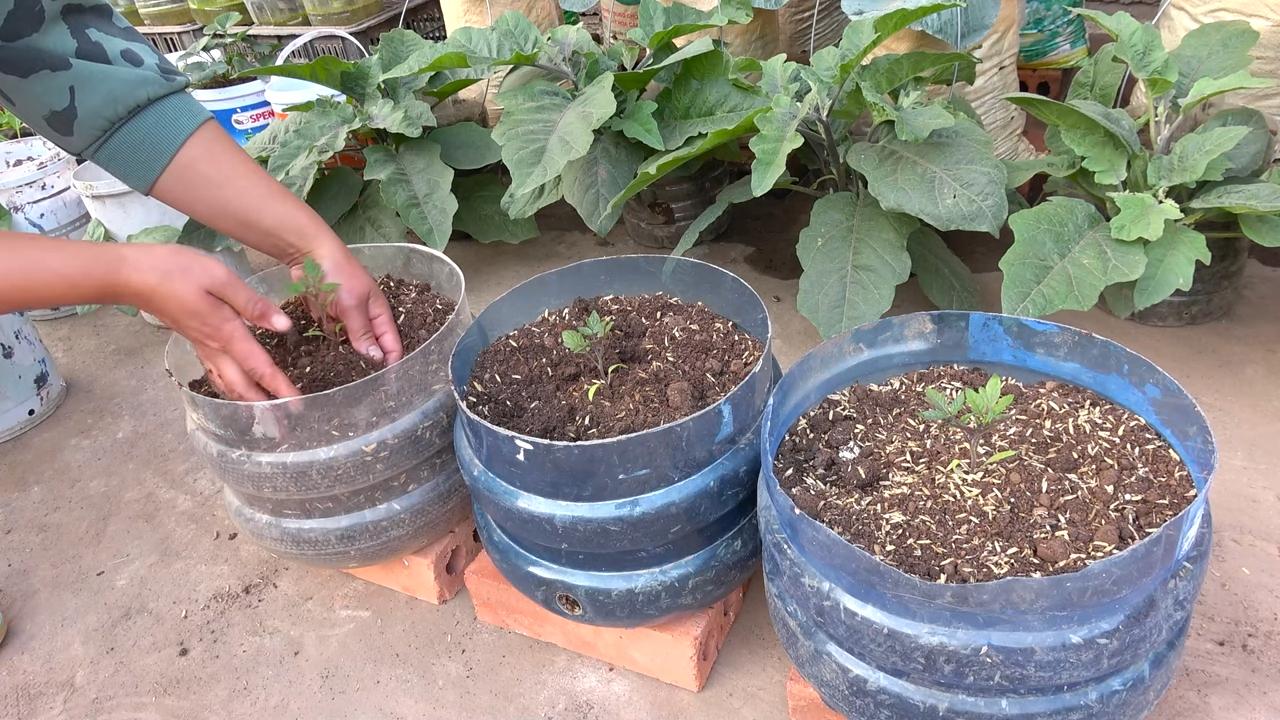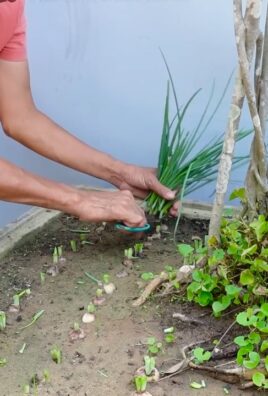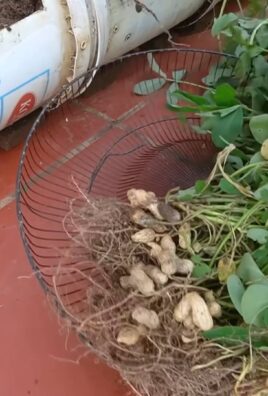Grow Sweet Cherry Tomatoes like a pro, even if you think you have a black thumb! Have you ever dreamed of plucking juicy, sun-ripened cherry tomatoes straight from your own backyard, bursting with flavor that no store-bought tomato can match? I know I have! This isn’t just about gardening; it’s about experiencing the joy of nurturing life and reaping the delicious rewards.
For centuries, home gardening has been a source of sustenance and connection to nature. From ancient Roman kitchen gardens to the victory gardens of World War II, growing your own food has always been a way to provide for yourself and your family. And while the scale might be smaller, the satisfaction of growing your own sweet cherry tomatoes is just as profound.
But let’s be honest, sometimes gardening can feel overwhelming. That’s where this DIY guide comes in! I’m going to share some simple, yet effective tricks and hacks that will help you grow sweet cherry tomatoes successfully, regardless of your experience level. We’ll cover everything from choosing the right variety and preparing your soil to providing the perfect amount of sunlight and water. Say goodbye to bland, tasteless tomatoes and hello to a bountiful harvest of sweet, juicy goodness! You’ll be amazed at how easy and rewarding it can be.

Growing Sweet Cherry Tomatoes: A DIY Guide to Bountiful Harvests
Okay, tomato lovers, let’s talk about growing sweet cherry tomatoes! I’m going to walk you through everything you need to know to get a fantastic harvest of these little bursts of sunshine right in your own backyard (or balcony!). Trust me, there’s nothing quite like popping a sun-warmed, homegrown cherry tomato straight into your mouth.
Choosing the Right Cherry Tomato Variety
Before we even get our hands dirty, let’s pick the perfect cherry tomato for you. There are tons of varieties, each with its own unique flavor and characteristics. Here are a few of my favorites:
* Sungold: These are incredibly sweet and fruity, almost like candy. They’re a golden-orange color and super popular for a reason!
* Sweet Million: As the name suggests, these produce a massive amount of small, red cherry tomatoes. They’re reliable and disease-resistant.
* Black Cherry: These have a rich, complex flavor with a hint of smokiness. They’re a beautiful dark purple-brown color.
* Juliet: These are slightly larger than typical cherry tomatoes, more like grape tomatoes. They’re firm, meaty, and great for snacking.
* Super Sweet 100: Another prolific producer, these are known for their exceptional sweetness.
Consider your taste preferences, the amount of space you have, and your local climate when making your choice. Seed packets usually have helpful information about each variety.
Starting Your Cherry Tomato Plants
You have two main options here: starting from seed or buying transplants. Starting from seed gives you more control and variety, but it requires a bit more time and effort. Buying transplants is quicker and easier, but you’ll be limited to what’s available at your local garden center.
Starting from Seed (My Preferred Method!)
1. Gather Your Supplies: You’ll need:
* Cherry tomato seeds (obviously!)
* Seed starting trays or small pots
* Seed starting mix (this is different from regular potting soil – it’s lighter and sterile)
* A spray bottle
* A heat mat (optional, but helpful)
* A grow light (also optional, but highly recommended)
2. Sow the Seeds: Fill your seed starting trays or pots with seed starting mix. Moisten the mix with your spray bottle – you want it damp, not soggy. Sow 2-3 seeds per cell or pot, about ¼ inch deep. Gently cover the seeds with more mix.
3. Provide Warmth and Light: Place the trays or pots on a heat mat (if using) and under a grow light (if using). The ideal temperature for germination is around 75-85°F. If you don’t have a heat mat, find a warm spot in your house. If you don’t have a grow light, place the trays or pots near a sunny window, but be aware that the seedlings may become leggy (tall and spindly) if they don’t get enough light.
4. Keep the Soil Moist: Use your spray bottle to keep the soil consistently moist, but not waterlogged. Check the soil daily and water as needed.
5. Thin the Seedlings: Once the seedlings have their first true leaves (the second set of leaves that appear after the initial seed leaves), thin them to one seedling per cell or pot. Choose the strongest, healthiest-looking seedling and snip off the others at the soil line with scissors. Don’t pull them out, as this can disturb the roots of the remaining seedling.
6. Harden Off the Seedlings: Before transplanting the seedlings outdoors, you need to “harden them off.” This means gradually exposing them to outdoor conditions over a period of 7-10 days. Start by placing them in a sheltered spot outdoors for an hour or two each day, gradually increasing the amount of time they spend outside. Protect them from strong winds and direct sunlight at first.
Buying Transplants
1. Choose Healthy Plants: Look for plants that are stocky, green, and have no signs of disease or pests. Avoid plants that are leggy, yellowed, or have spots on their leaves.
2. Check the Roots: Gently remove a plant from its container and inspect the roots. They should be white or light brown and not circling tightly around the pot. If the roots are root-bound, gently loosen them before planting.
Preparing Your Garden Bed or Containers
Whether you’re growing in the ground or in containers, proper soil preparation is crucial for success.
In the Garden Bed
1. Choose a Sunny Location: Cherry tomatoes need at least 6-8 hours of sunlight per day.
2. Prepare the Soil: Amend the soil with plenty of compost or other organic matter. This will improve drainage, aeration, and fertility.
3. Check the Soil pH: Tomatoes prefer a slightly acidic soil pH of around 6.0-6.8. You can test your soil pH with a soil testing kit. If the pH is too high, you can lower it by adding sulfur or peat moss.
In Containers
1. Choose the Right Size Container: Cherry tomatoes need a container that is at least 12 inches in diameter and 12 inches deep. Larger containers are even better, as they will provide more room for the roots to grow.
2. Use High-Quality Potting Mix: Don’t use garden soil in containers, as it will compact and not drain well. Use a high-quality potting mix that is specifically formulated for containers.
3. Ensure Good Drainage: Make sure your containers have drainage holes to prevent waterlogging.
Transplanting Your Cherry Tomato Plants
Now for the fun part – getting those little plants into their new homes!
1. Choose a Cloudy Day: Transplanting on a cloudy day will help reduce stress on the plants.
2. Dig a Hole: Dig a hole that is slightly larger than the root ball of the plant.
3. Add Fertilizer: Add a handful of slow-release tomato fertilizer to the bottom of the hole. This will provide the plants with a steady supply of nutrients.
4. Plant the Seedling: Gently remove the plant from its container and loosen the roots if they are root-bound. Place the plant in the hole and backfill with soil. Bury the stem up to the first set of leaves. This will encourage the plant to develop more roots along the buried stem.
5. Water Thoroughly: Water the plant thoroughly after transplanting.
6. Add Support: Cherry tomato plants can get quite large and sprawling, so it’s important to provide them with support. You can use stakes, cages, or trellises. I personally prefer cages, as they provide all-around support. Install the support at the time of transplanting to avoid damaging the roots later.
7. Mulch: Apply a layer of mulch around the plants to help retain moisture, suppress weeds, and regulate soil temperature. Straw, shredded leaves, or wood chips are all good options.
Caring for Your Cherry Tomato Plants
Once your plants are in the ground, it’s time to give them some TLC!
1. Water Regularly: Water deeply and regularly, especially during hot, dry weather. Aim to keep the soil consistently moist, but not waterlogged. Water at the base of the plant to avoid wetting the foliage, which can lead to disease.
2. Fertilize Regularly: Feed your plants with a tomato fertilizer every 2-3 weeks. Follow the instructions on the fertilizer package.
3. Prune Your Plants: Pruning can help improve air circulation, reduce disease, and encourage fruit production. Remove suckers (the small shoots that grow between the main stem and the branches) to direct the plant’s energy into fruit production.
4. Watch Out for Pests and Diseases: Keep an eye out for common tomato pests and diseases, such as aphids, tomato hornworms, and early blight. Take action promptly if you notice any problems. There are many organic pest control and disease control options available.
Harvesting Your Cherry Tomatoes
This is the best part! Cherry tomatoes are usually ready to harvest about 60-80 days after transplanting.
1. Pick When Ripe: Harvest the tomatoes when they are fully colored and slightly soft to the touch. They should easily detach from the vine.
2. Harvest Regularly: Harvest regularly to encourage the plant to produce more fruit.
3. Enjoy! Eat your cherry tomatoes fresh, add them to salads, or use them in your favorite recipes.
Troubleshooting Common Problems
Even with the best care, you may encounter some problems along the way. Here are a few common issues and how to address them:
* Blossom End Rot: This is caused by a calcium deficiency. Make sure your soil has adequate calcium and water regularly to help the plants absorb it.
* Cracking: This is caused

Conclusion
So, there you have it! Growing sweet cherry tomatoes at home, while it might seem daunting at first, is incredibly rewarding and surprisingly achievable with these simple DIY tricks. We’ve walked you through the essential steps, from selecting the right variety and preparing your soil to providing the necessary support and warding off common pests. But why is this DIY approach a must-try?
Firstly, the taste. Store-bought cherry tomatoes simply can’t compare to the burst of sunshine and sweetness you get from a homegrown variety, ripened to perfection on the vine. The difference is truly remarkable. Secondly, you have complete control over what goes into your food. No more worrying about pesticides or unknown chemicals – you know exactly what your tomatoes have been exposed to. This is especially important if you’re conscious about eating organic and healthy produce. Thirdly, it’s incredibly satisfying! There’s a unique joy in nurturing a plant from seed (or seedling) to harvest, and then enjoying the fruits (or vegetables!) of your labor. It’s a tangible connection to nature that can be incredibly grounding and therapeutic.
Beyond the basic method outlined, there are plenty of ways to customize your cherry tomato growing experience. Consider experimenting with different varieties. ‘Sungold’ is renowned for its exceptional sweetness, while ‘Black Cherry’ offers a more complex, earthy flavor. You could also try growing your tomatoes in hanging baskets for a decorative and space-saving option, or even indoors with the help of grow lights if you live in a colder climate. Companion planting is another avenue to explore. Basil, for example, is said to improve the flavor of tomatoes and repel certain pests. Marigolds are also excellent for deterring nematodes.
Don’t be afraid to get creative with your supports, too. While tomato cages are readily available, you can easily fashion your own using bamboo stakes and twine, or even repurpose old ladders or trellises. The key is to provide adequate support as the plants grow and the tomatoes become heavy.
Finally, remember that growing sweet cherry tomatoes is a learning process. Don’t be discouraged if you encounter setbacks along the way. Every season brings new challenges and opportunities to refine your techniques. The most important thing is to get started, experiment, and have fun!
We wholeheartedly encourage you to give this DIY trick a try. Imagine the delicious salads, snacks, and sauces you can create with your own homegrown sweet cherry tomatoes. Picture the satisfaction of sharing your bounty with friends and family. And think of the positive impact you’ll be making on your health and the environment.
Once you’ve embarked on your cherry tomato growing adventure, we’d love to hear about your experience! Share your tips, tricks, and triumphs in the comments below. Let us know what varieties you’re growing, what challenges you’ve faced, and what delicious recipes you’ve created. Together, we can build a community of passionate home gardeners and spread the joy of growing sweet cherry tomatoes. So, grab your seeds, get your hands dirty, and get ready to enjoy the sweetest, most flavorful tomatoes you’ve ever tasted!
Frequently Asked Questions (FAQ)
1. What is the best variety of sweet cherry tomato to grow?
The “best” variety really depends on your personal preferences! However, some consistently popular and highly-rated sweet cherry tomato varieties include:
* **Sungold:** Known for its exceptional sweetness and bright orange color. It’s a favorite among many gardeners.
* **Sweet Million:** A prolific producer of small, very sweet red cherry tomatoes. It’s a reliable choice for beginners.
* **Black Cherry:** Offers a more complex, earthy, and slightly smoky flavor compared to other sweet varieties.
* **Super Sweet 100:** As the name suggests, this variety produces an abundance of incredibly sweet, bite-sized tomatoes.
* **Juliet:** A hybrid variety that produces slightly larger, oblong-shaped cherry tomatoes with a sweet and tangy flavor.
Consider your taste preferences, growing conditions (e.g., space, sunlight), and disease resistance when choosing a variety. Don’t be afraid to experiment with different types to find your personal favorite!
2. How much sunlight do sweet cherry tomatoes need?
Sweet cherry tomatoes thrive in full sun, which means they need at least 6-8 hours of direct sunlight per day. Insufficient sunlight can lead to leggy plants, reduced fruit production, and less flavorful tomatoes. Choose a planting location that receives ample sunlight throughout the day. If you’re growing tomatoes indoors, you’ll need to supplement with grow lights to provide the necessary light intensity.
3. What kind of soil is best for growing sweet cherry tomatoes?
Well-draining soil that is rich in organic matter is ideal for growing sweet cherry tomatoes. Amend your soil with compost, aged manure, or other organic materials to improve its fertility and drainage. A slightly acidic soil pH (around 6.0-6.8) is also preferred. You can test your soil pH with a home testing kit and adjust it accordingly with lime (to raise the pH) or sulfur (to lower the pH).
4. How often should I water my sweet cherry tomato plants?
Water your sweet cherry tomato plants deeply and regularly, especially during hot and dry weather. Aim to keep the soil consistently moist but not waterlogged. Water at the base of the plants to avoid wetting the foliage, which can increase the risk of fungal diseases. A good rule of thumb is to water when the top inch of soil feels dry to the touch. Mulching around the plants can help retain moisture and suppress weeds.
5. How do I prevent pests and diseases from affecting my sweet cherry tomato plants?
There are several things you can do to prevent pests and diseases:
* **Choose disease-resistant varieties:** Look for varieties that are labeled as resistant to common tomato diseases like Fusarium wilt, Verticillium wilt, and early blight.
* **Practice crop rotation:** Avoid planting tomatoes in the same location year after year to prevent the buildup of soilborne diseases.
* **Provide good air circulation:** Space your plants adequately to allow for good air circulation, which helps prevent fungal diseases.
* **Water at the base of the plants:** Avoid wetting the foliage when watering to reduce the risk of fungal diseases.
* **Use organic pest control methods:** If you encounter pests, try using organic pest control methods like insecticidal soap, neem oil, or Bacillus thuringiensis (Bt).
* **Remove diseased foliage promptly:** If you notice any signs of disease, remove the affected foliage immediately to prevent the spread of the disease.
6. When should I harvest my sweet cherry tomatoes?
Harvest your sweet cherry tomatoes when they are fully colored, slightly soft to the touch, and easily detach from the vine. The exact color will depend on the variety you’re growing. Taste one to make sure it’s sweet and flavorful before harvesting the rest. Cherry tomatoes will continue to ripen after they’ve been picked, but they will taste best if they are allowed to ripen fully on the vine.
7. Can I grow sweet cherry tomatoes in containers?
Yes, you can definitely grow sweet cherry tomatoes in containers! Choose a large container (at least 10-15 gallons) with drainage holes. Use a high-quality potting mix and provide adequate support for the plants as they grow. Container-grown tomatoes may require more frequent watering and fertilization than those grown in the ground.
8. How do I fertilize my sweet cherry tomato plants?
Fertilize your sweet cherry tomato plants regularly with a balanced fertilizer that is specifically formulated for tomatoes. Follow the instructions on the fertilizer package. Avoid over-fertilizing, as this can lead to excessive foliage growth and reduced fruit production. You can also supplement with organic fertilizers like compost tea or fish emulsion.
9. What are some common problems when growing sweet cherry tomatoes?
Some common problems include:
* **Blossom end rot:** Caused by calcium deficiency. Ensure consistent watering and add calcium to the soil.
* **Early blight:** A fungal disease that causes dark spots on the leaves. Remove affected foliage and use a fungicide if necessary.
* **Tomato hornworms:** Large green caterpillars that can defoliate plants. Handpick them off the plants or use Bacillus thuringiensis (Bt).
* **Aphids:** Small, sap-sucking insects that can weaken plants. Spray with insecticidal soap.
So, there you have it! Growing sweet cherry tomatoes at home, while it might seem daunting at first, is incredibly rewarding and surprisingly achievable with these simple DIY tricks. We’ve walked you through the essential steps, from selecting the right variety and preparing your soil to providing the necessary support and warding off common pests. But why is this DIY approach a must-try?
Firstly, the taste. Store-bought cherry tomatoes simply can’t compare to the burst of sunshine and sweetness you get from a homegrown variety, ripened to perfection on the vine. The difference is truly remarkable. Secondly, you have complete control over what goes into your food. No more worrying about pesticides or unknown chemicals – you know exactly what your tomatoes have been exposed to. This is especially important if you’re conscious about eating organic and healthy produce. Thirdly, it’s incredibly satisfying! There’s a unique joy in nurturing a plant from seed (or seedling) to harvest, and then enjoying the fruits (or vegetables!) of your labor. It’s a tangible connection to nature that can be incredibly grounding and therapeutic.
Beyond the basic method outlined, there are plenty of ways to customize your cherry tomato growing experience. Consider experimenting with different varieties. ‘Sungold’ is renowned for its exceptional sweetness, while ‘Black Cherry’ offers a more complex, earthy flavor. You could also try growing your tomatoes in hanging baskets for a decorative and space-saving option, or even indoors with the help of grow lights if you live in a colder climate. Companion planting is another avenue to explore. Basil, for example, is said to improve the flavor of tomatoes and repel certain pests. Marigolds are also excellent for deterring nematodes.
Don’t be afraid to get creative with your supports, too. While tomato cages are readily available, you can easily fashion your own using bamboo stakes and twine, or even repurpose old ladders or trellises. The key is to provide adequate support as the plants grow and the tomatoes become heavy.
Finally, remember that growing sweet cherry tomatoes is a learning process. Don’t be discouraged if you encounter setbacks along the way. Every season brings new challenges and opportunities to refine your techniques. The most important thing is to get started, experiment, and have fun!
We wholeheartedly encourage you to give this DIY trick a try. Imagine the delicious salads, snacks, and sauces you can create with your own homegrown sweet cherry tomatoes. Picture the satisfaction of sharing your bounty with friends and family. And think of the positive impact you’ll be making on your health and the environment.
Once you’ve embarked on your cherry tomato growing adventure, we’d love to hear about your experience! Share your tips, tricks, and triumphs in the comments below. Let us know what varieties you’re growing, what challenges you’ve faced, and what delicious recipes you’ve created. Together, we can build a community of passionate home gardeners and spread the joy of growing sweet cherry tomatoes. So, grab your seeds, get your hands dirty, and get ready to enjoy the sweetest, most flavorful tomatoes you’ve ever tasted!
Frequently Asked Questions (FAQ)
1. What is the best variety of sweet cherry tomato to grow?
The “best” variety really depends on your personal preferences! However, some consistently popular and highly-rated sweet cherry tomato varieties include:
* **Sungold:** Known for its exceptional sweetness and bright orange color. It’s a favorite among many gardeners.
* **Sweet Million:** A prolific producer of small, very sweet red cherry tomatoes. It’s a reliable choice for beginners.
* **Black Cherry:** Offers a more complex, earthy, and slightly smoky flavor compared to other sweet varieties.
* **Super Sweet 100:** As the name suggests, this variety produces an abundance of incredibly sweet, bite-sized tomatoes.
* **Juliet:** A hybrid variety that produces slightly larger, oblong-shaped cherry tomatoes with a sweet and tangy flavor.
Consider your taste preferences, growing conditions (e.g., space, sunlight), and disease resistance when choosing a variety. Don’t be afraid to experiment with different types to find your personal favorite!
2. How much sunlight do sweet cherry tomatoes need?
Sweet cherry tomatoes thrive in full sun, which means they need at least 6-8 hours of direct sunlight per day. Insufficient sunlight can lead to leggy plants, reduced fruit production, and less flavorful tomatoes. Choose a planting location that receives ample sunlight throughout the day. If you’re growing tomatoes indoors, you’ll need to supplement with grow lights to provide the necessary light intensity.
3. What kind of soil is best for growing sweet cherry tomatoes?
Well-draining soil that is rich in organic matter is ideal for growing sweet cherry tomatoes. Amend your soil with compost, aged manure, or other organic materials to improve its fertility and drainage. A slightly acidic soil pH (around 6.0-6.8) is also preferred. You can test your soil pH with a home testing kit and adjust it accordingly with lime (to raise the pH) or sulfur (to lower the pH).
4. How often should I water my sweet cherry tomato plants?
Water your sweet cherry tomato plants deeply and regularly, especially during hot and dry weather. Aim to keep the soil consistently moist but not waterlogged. Water at the base of the plants to avoid wetting the foliage, which can increase the risk of fungal diseases. A good rule of thumb is to water when the top inch of soil feels dry to the touch. Mulching around the plants can help retain moisture and suppress weeds.
5. How do I prevent pests and diseases from affecting my sweet cherry tomato plants?
There are several things you can do to prevent pests and diseases:
* **Choose disease-resistant varieties:** Look for varieties that are labeled as resistant to common tomato diseases like Fusarium wilt, Verticillium wilt, and early blight.
* **Practice crop rotation:** Avoid planting tomatoes in the same location year after year to prevent the buildup of soilborne diseases.
* **Provide good air circulation:** Space your plants adequately to allow for good air circulation, which helps prevent fungal diseases.
* **Water at the base of the plants:** Avoid wetting the foliage when watering to reduce the risk of fungal diseases.
* **Use organic pest control methods:** If you encounter pests, try using organic pest control methods like insecticidal soap, neem oil, or Bacillus thuringiensis (Bt).
* **Remove diseased foliage promptly:** If you notice any signs of disease, remove the affected foliage immediately to prevent the spread of the disease.
6. When should I harvest my sweet cherry tomatoes?
Harvest your sweet cherry tomatoes when they are fully colored, slightly soft to the touch, and easily detach from the vine. The exact color will depend on the variety you’re growing. Taste one to make sure it’s sweet and flavorful before harvesting the rest. Cherry tomatoes will continue to ripen after they’ve been picked, but they will taste best if they are allowed to ripen fully on the vine.
7. Can I grow sweet cherry tomatoes in containers?
Yes, you can definitely grow sweet cherry tomatoes in containers! Choose a large container (at least 10-15 gallons) with drainage holes. Use a high-quality potting mix and provide adequate support for the plants as they grow. Container-grown tomatoes may require more frequent watering and fertilization than those grown in the ground.
8. How do I fertilize my sweet cherry tomato plants?
Fertilize your sweet cherry tomato plants regularly with a balanced fertilizer that is specifically formulated for tomatoes. Follow the instructions on the fertilizer package. Avoid over-fertilizing, as this can lead to excessive foliage growth and reduced fruit production. You can also supplement with organic fertilizers like compost tea or fish emulsion.
9. What are some common problems when growing sweet cherry tomatoes?
Some common problems include:
* **Blossom end rot:** Caused by calcium deficiency. Ensure consistent watering and add calcium to the soil.
* **Early blight:** A fungal disease that causes dark spots on the leaves. Remove affected foliage and use a fungicide if necessary.
* **Tomato hornworms:** Large green caterpillars that can defoliate plants. Handpick them off the plants or use Bacillus thuringiensis (Bt).
* **Aphids:** Small, sap-sucking insects that can weaken plants. Spray with insecticidal soap.
* **Sunscald:** Occurs when tomatoes are exposed to too much direct sunlight. Provide shade during the hottest part of the day.
10. Can I save seeds from my sweet cherry tomatoes to plant next year?
You can save seeds from heirloom varieties of sweet cherry tomatoes, but not from hybrid varieties. Hybrid varieties will not produce true-to-type offspring. To save seeds, allow the tomatoes to fully ripen on the vine. Scoop out the seeds and pulp and ferment them in a jar of water for a few days. This will help remove the gelatinous coating around the seeds. Rinse the seeds thoroughly and dry them on a paper towel. Store the dried seeds in an airtight container in a cool, dark place.




Leave a Comment